Restored Ming Dynasty porcelain put on display at Palace Museum
Updated: 2015-08-11 07:57
By Xinhua(China Daily)
|
||||||||
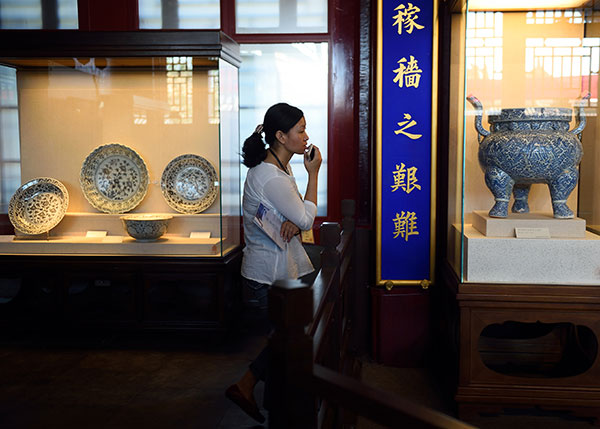 |
|
A visitor examines porcelains from the Ming Dynasty (1368-1644) during a three-month exhibition at the Palace Museum in Beijing in June. The porcelains on display are both perfect samples and restored ones from unearthed ceramic chips. [Jin Liangkuai/Xinhua] |
About 160 pieces of porcelain considered not good enough for China's royal court and shattered 580 years ago have finally made their way to the Forbidden City.
An exhibition at the Palace Museum features Ming Dynasty (1368-1644) imperial kilns from Jingdezhen, a porcelain town in Jiangxi province.
It has brought together for the first time pieces restored from unearthed ceramic chips and the museum's well-preserved royal collections.
Lu Chenglong, deputy chief of the museum's Utensil Department, said the three-month-long exhibition, which closes on Sept 3, was overdue.
"We had been planning this kind of exhibition since as early as the 1990s, but could not do it for various reasons," he said.
Following increased cooperation with local museums, the porcelain finally left Jingdezhen for Beijing to be displayed alongside 137 perfect items made at the same royal kilns.
"Although a great deal of royal porcelain was passed down by the imperial families, there is so much we don't know about royal porcelain production at that time," Lu said.
"Visitors can clearly observe the difference by comparing the substandard and perfect pieces," he said.
A man surnamed Wu, who runs an antiques store in Beijing, has visited the exhibition twice in two months. "The comparisons seen in the displays are very valuable. They help us to improve our understanding of ancient porcelain," he said.
He said the defective pieces are either misshapen or have flawed colors or drawings.
Since the 1970s, Chinese archaeologists have unearthed dozens of metric tons of ceramic chips from the ruins of ancient royal kilns in Jingdezhen and have restored 1,400 pieces.
Lu, who has studied ancient porcelain for 31 years, said, "Restoring these chips is a huge and time-consuming project, but very valuable."
Due to fragility, wars, regime change, natural disasters and other factors, a large amount of porcelain that passed quality inspections by kiln supervisors disappeared, Lu said.
Without archaeological excavation of the ancient royal kilns, knowledge of them and the porcelain they produced would have remained sketchy, he said.
Lu said one advantage for Chinese porcelain researchers is that ceramics - either chips or vessels - appear new after a wash, no matter how long they have been buried in the earth or been on a sunken ship.
Records show that during the reign of Emperor Wanli from 1572 to 1620 - the heyday of porcelain production in China - 100,000 people worked at royal and private kilns in Jingdezhen. Some of their products were exported to Africa, Europe and the Americas.
At the exhibition, 10 vessels, including an octagonal candle holder, stand out for their Islamic influence.
Visitor Yuan Xiaomei from Heilongjiang province was surprised by the tough production standards at ancient royal kilns.
"The restored pieces are exquisite enough in my view, but they were still shattered and buried. Such high standards could be one of the reasons why our porcelain-firing techniques were the best in the world at that time," she said.
Lu said the defective pieces provide precious sources for a study of China's antique porcelain, and restoration work is moving forward.
More than 1,000 visitors a day have seen the exhibition at the Palace Museum, which has a collection of 360,000 pieces of porcelain.
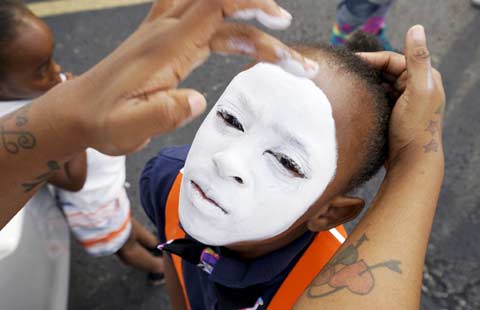
 The world in photos: Aug 3-9
The world in photos: Aug 3-9
 'Most beautiful road on water'
'Most beautiful road on water'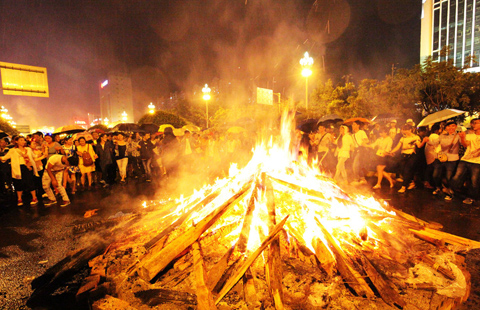
 Ethnic groups celebrate the Torch Festival
Ethnic groups celebrate the Torch Festival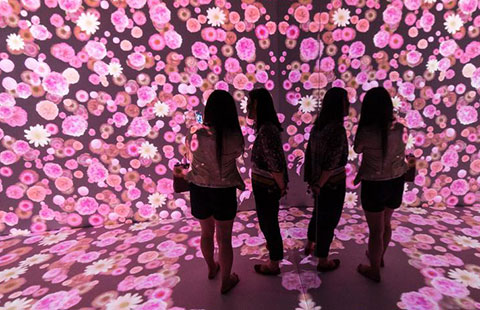
 Ten photos you don't wanna miss (Aug 3-9)
Ten photos you don't wanna miss (Aug 3-9)
 30 historic and cultural neighborhoods to visit in China
30 historic and cultural neighborhoods to visit in China
 Beijing Museum of Natural History unveils 'Night at the Museum'
Beijing Museum of Natural History unveils 'Night at the Museum'
 Sun Yang wins third consecutive 800m free gold at worlds
Sun Yang wins third consecutive 800m free gold at worlds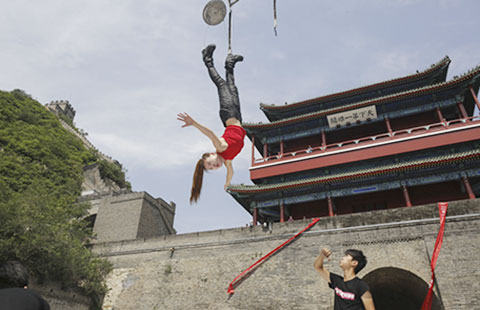
 Aerial escape
Aerial escape
Most Viewed
Editor's Picks

|

|

|

|

|

|
Today's Top News
Govt encourages people to work 4.5 days a week
Officials to pave way for Xi's visit
China, US to exchange officials for Xi's visit
State Council approves plan to overhaul SOEs, claims report
S. Korean president mulls whether to join China's war anniversary
Sun Yang is no-show for 1,500 free final at worlds
China willing to work with US to contribute to world peace, stability
China asks further investigation on MH370
US Weekly

|

|






